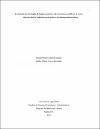Evaluación de estrategias de implementación sobre turismo accesible en el centro histórico de la Candelaria para turistas con discapacidad auditiva
Fecha de publicación
2020-06-05Idioma del documento
spaResumen
El presente proyecto busca hacer conocer la importancia de implementar el turismo accesible para personas con discapacidad auditiva en el centro histórico de la Candelaria ya que es uno los principales atractivos turístico que tiene la ciudad de Bogotá, donde se ve la diversidad cultural, arquitectónica, historias políticas y enfrentamientos que relatan cada una de sus calles, así mismo es considerada patrimonio cultural de Colombia. Sin embargo, carece de accesibilidad turística para personas con discapacidad auditiva; el Instituto Distrital de Turismo (IDT) ha diseñado y creado planes, programas y el gobierno tiene leyes, decretos y normas para la inclusión turística de sordos, pero se quedan cortos en implementación, sensibilización, capacitación y difusión de los mismos.
Para evaluar esta situación se hará un enfoque de investigación cualitativa con método descriptivo el cual busca analizar y observar las razones por las cuales no hay una ejecución de los documentos que se han creados para el turismo accesible, primero se realizaron entrevistas a prestadores de servicios turísticos y expertos en turismo, realizando trabajo de observación para evidenciar la escases de implementación. Luego se hizo un análisis crítico de todos estos documentos calificados a través de la matriz de Vester y finalmente se creó un plan de mejoramiento para implementar el turismo accesible en este destino turístico con base en el trabajo de campo que se observó y las opiniones de los expertos entrevistados.
Abstract
This project seeks to know the importance of implementing accessible tourism for people with hearing impairment in the historic center of the Candelaria since it is one of the main tourist attractions of the city of Bogotá, where cultural, architectural diversity, stories are seen policies and confrontations that relate each of its streets, likewise it is the cultural heritage of Colombia. However, it lacks tourist access for people with hearing impairment; The District Tourism Institute (IDT) has designed and created airplanes, programs and the government has laws, decrees and regulations for the tourist inclusion of the deaf, but they fall short of implementation, awareness, training and dissemination of them.
In order to evaluate this situation, a qualitative research approach will be carried out with a descriptive method which seeks to analyze and observe the reasons why there is no execution of the documents that have been generated for accessible tourism, first interviews will be conducted with tourism service providers and tourism experts, carry out observation work to demonstrate the scales of implementation. A critical analysis of all these qualified documents was then made through the data matrix and finally an improvement plan was created to implement accessible tourism in this tourist destination based on the field work that is identified and the opinions of the Experts interviewed.
Palabras clave
Colecciones
 Esta obra está bajo licencia internacional Creative Commons Reconocimiento-NoComercial 4.0.
Esta obra está bajo licencia internacional Creative Commons Reconocimiento-NoComercial 4.0.

